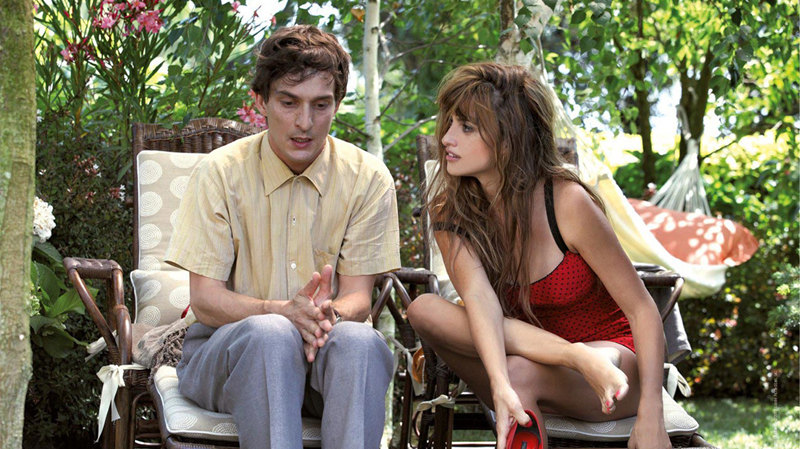Arthur Hamilton (John Randolph) has always played by the rules and now he’s paying for it. The 50-something banker has a respectable job, a dream house in Scarsdale, and a devoted wife (Frances Reid) and the only thing he really wants is a way to opt out of all of it. And he doesn’t even know he wants that because Arthur left desire behind along with his youth. He trudges through each day as numbly as possible until a mysterious phone call from a friend he thought long dead sparks a guttering flame of curiosity, maybe even… hope.
He follows the voice from the grave to a meat-packing plant which turns out to be a front for a mysterious and sinister corporation. If the slabs of raw beef strung up in shabby lines aren’t foreboding enough, alarms should be ringing at the sight of a hand-scribbled sign reading “NO ADMITANCE. EMPLOYES ONLY.” Poor spelling does not promise quality control.
But Arthur is desperate, though he only realizes the depths of his total disenfranchisement when presented with an astonishing offer: for a huge wad of cash, this unnamed company will provide him with an entirely new life. The package includes relocation, fake credentials for a new identity, and total reconstructive surgery. A clean break, a fresh start, the ultimate dream. What’s this business about needing to find a suitable corpse to fake his death? Just sign here.
The company’s service is admittedly better than its spelling. Saggy-faced, slouching Arthur has to endure a series of painful operations (graphically portrayed for maximum audience discomfort) and months of grueling rehab, but when the bandages come off he looks exactly like Rock Hudson. What a deal! Hudson was only ten years younger than Randolph, but a certified Hollywood hunk is an entirely different beast so you can understand why the plastic surgeon declares him his greatest masterpiece, the finest Second he has ever sculpted. Hudson becomes Tony Wilson, a dashing Bohemian painter who lives it up in a California beach town where he finds new love (the moodily angular Salome Jens) and gets to stomp around naked in a vat of grapes with a bunch of hippies.
Far more fantastical than the plot, adapted from a novel by David Ely, is the signature camerawork by legendary cinematographer James Wong Howe. From the opening montage of distorted eyeballs and gaping toothy mouths (another title sequence designed by Saul Bass), “Seconds” (1966) is a fish-eye frenzy, a fun house mirror world that never looks quite right because it never is, and never was. Working in the pre-Steadicam era, Howe tracks the camera nervously through crowded spaces, even mounting the camera directly on to the actors’ backs for some of the most unnerving and attention-grabbing shots. Viewers who prefer an invisible shooting style may become agitated, but that’s what Frankenheimer and Howe are after, and they achieve it with proudly ostentatious aplomb. Every image disorients, sometimes to the point of nausea for 1966 audiences who did not receive the film warmly at all.
“Seconds” could be either dismissed or praised as a super-sized “Twilight Zone” episode. The paranoid photography guarantees an unhappy outcome, but the chilling ending (one of the all-time greats) is no less terrifying for its relative predictability. Tony Wilson’s dream life turns out to be just another Arthur Hamilton nightmare, a variation on the one he’d been living for a long time. Looking like Rock Hudson apparently doesn’t solve every problem, a notion some viewers have taken as an insight into the closeted star’s life.
Matinee idol Hudson is usually described as being cast against type in “Seconds,” though he had already appeared in his share of jaundiced Douglas Sirk melodramas. Hudson does a remarkable job of separating his character from his star persona. He remains stodgy, self-loathing Arthur Hamilton throughout, even when he’s frolicking in a hippie Bacchanalia. Even when you spend enough money to get yourself buffed and polished into the ultimate American dreamboat, you remain drearily and eternally just who you are. Well, not eternally, of course, but long enough.
Video:
The film is presented in “Frankenheimer’s preferred aspect ratio” of 1.75:1. James Wong Howe’s brilliant camerawork deserves a top-flight high-def transfer, and Criterion has certainly provided it. The image detail is razor sharp throughout and the contrast in the B&W photography is equally stark. The grain structure is rich though not particularly thick. Sharp shadow-lines really stand out. This is a fantastic transfer.
Audio:
The linear PCM Mono track is crisp and sounds wonderfully hollow when it’s supposed to (which is most of the time). Jerry Goldsmith’s moody, marvelous score has its occasional flourishes (that’s meant to be an understatement) and it all sounds deep and resonant here. Optional English subtitles support the English audio.
Extras:
Criterion has included an eclectic array of extras for this Blu-ray release.
The film is accompanied by a commentary track by John Frankenheimer that was recorded in 1997 and originally included on the film’s laser disc release. Commentary tracks were seldom wall-to-wall back then so this includes some dead space, but Frankenheimer, who died in 2002, makes efficient use of his time, talking in depth about the film’s production as well as its disappointing reception and subsequent acceptance as a critical and cult favorite.
Criterion includes an interview with actor Alec Baldwin (14 min.) who worked on Frankenheimer’s last film “Path to War.” Baldwin apparently was close to the filmmaker and shares a few affectionate anecdotes about him. This feature is pretty short on analysis, but enjoyable.
“A Second Look” (2013, 18 min.) combines interviews with Evans Frankenheimer, the director’s widow, and actress Salome Jens. Jens relates an interesting debate she had with the director. She believed her character was in love with Tony (Hudson). Frankenheimer did not. She now acknowledges that he made the right choice. Another trivia bit: Leonard Nimoy had a role that was left on the editing room floor.
Film scholars R. Barton Palmer and Murray Pomerance (2013, 12 min.) situate “Seconds” as the final film in Frankenheimer’s “paranoia trilogy (after “The Manchurian Candidate” and “Seven Days in May”) and then analyze a few scenes from “Seconds.” This feature probably needs to be twice as long to give Palmer (who narrates) and Pomerance (who co-wrote with Palmer) more time to elaborate in detail, but it’s still an insightful feature.
“Hollywood on the Hudson” is an excerpt from a 1965 WNBC news special (4 min.) which is shot on the film’s location in Scarsdale and includes a very brief interview with Rock Hudson. The disc also includes a 1971 interview of John Frankenheimer (10 min.) which originally aired on Canadian television in 1971.
The all-too-slim 16-page insert booklet features an essay by critic David Sterritt.
Film Value:
John Frankenheimer couldn’t possibly have expected the American public to swallow this paranoid fable about a corporation so soulless it’s willing to turn life itself into a commodity. He’s obviously just another socialist liberal who hates capitalism. Why not go all the way, and sell us a story about a company that wants to patent human genes or privatize water? Absurd.
Audiences in 1966 weren’t ready for such an unnerving experience, but “Seconds” has justly gained a considerable reputation in the past 40+ years. This high-def transfer from Criterion is nothing short of spectacular, and the extras are engaging though they perhaps leave us wanting a little more scholarly analysis of such a fascinating and multi-layered film. Regardless, this Blu-ray release of “Seconds” comes highly recommended.


